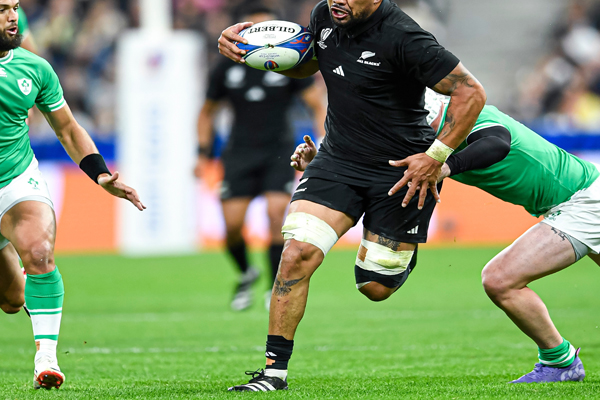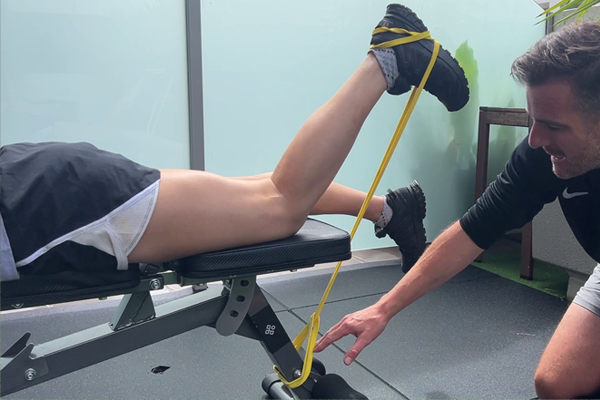
Returning to Sport following Knee Injuries
The 4 Key Rehab Principles
by Krisitn Cameron23 Nov 2024
Knowing when to return to sport following a knee injury can be tricky. All too often I have seen athletes return to play too early and further injure their knee, causing unnecessary pain and significant time off the field or court.
In my role as physiotherapist to the Wests Tigers NRLW team, there are four rehabilitation principles that I strictly adhere to when it comes to deciding whether an athlete is ready to get back to sport:
- Swelling Management
- Proprioception
- Progressive loading
- Sport-specific exercise
Let’s look more into each of these points.
Swelling Management

The first and one of the most basic measures I will use to assess if an athlete is ready to return to sport is swelling. Inflammation can cause pain and muscle inhibition which decreases the control of the muscles surrounding the knee and increases the risk of re-injury or even further injury, so I will not send an athlete back out on that field unless I am confident they have full control over their knee. There are a few ways to do this including: Visually – Is the knee visibly swollen in comparison to the other knee? Range of motion – The athlete should have full pain free range of motion in the knee joint. Special testing – There are a few tests a physiotherapist can perform to assess whether there is any remaining inflammation in the knee joint.
Proprioception

Proprioception is the awareness of our body within the surrounding space. It is the reason we are able to hop to a specific point or keep our balance when standing on one leg. When our knee is injured, the structures responsible for proprioception are damaged, and so our knee has less control than it did before – increasing the risk for re-injury. Luckily, these structures can be retrained, and the time that takes depends on both the severity of the injury and the consistency of the rehabilitation exercises you are doing. I will always include balance exercises as well as jump/hop exercises in any knee rehabilitation program I prescribe for an athlete, and to judge whether an athlete is ready to return to sport, I will not only look at whether you can complete these movements successfully, but also at the quality of the movement – looking for things such as: Does the knee buckle inward? Does the athlete unconsciously weight-bear more through the uninjured side? Etc.
Progressive Loading

Our body loves loading. Loading promotes healing within injured tissue and tells our body exactly how those foundations should be laid, but it is vitally important not to overload those damaged fibres as they heal. Do nothing and the tissue won’t heal as ideally as it could but do too much and the tissue could be damaged further. It is a delicate balance. This is why a progressive program works best for injury recovery. To begin any knee rehabilitation program, the first and most important goal is to get the muscles surrounding the joint firing again. Following that, light amounts of load should be added to any exercises, getting progressively heavier as the tissue heals. To be able to return to sport, an athlete needs to have almost equal strength through both limbs – usually somewhere within 10% is adequate. We can measure this using devices such as dynamometers, or even by simply measuring the number of a specific exercise – such as a single leg squat – the athlete can perform on each leg.
Sport-specific Exercise

When returning to sport, linear loading – squats, deadlifts, etc. – is often not enough on its own. If we think of the demands placed on the body during most sporting activities, they are rarely in only one direction, and the body needs to be able to move effectively in multiple different ways – think of the quick change of direction and twisting while dribbling in soccer, the rotational and driving forces required while tackling in rugby league, or even simply the pivot motion essential to a successful golf-swing. If a player returns to play without incorporating any exercises that mimic the demands placed on their knee for their specific sport, they will again be more at risk of injury. Sport-specific exercise should be incorporated into the rehabilitation program in the mid to late rehabilitation phases and should be able to be completed with no pain or dysfunction before returning to sport.
As the sporting population continues to thrive and the overall quality of sport improves, higher forces are being put through our knees, making knee joint injuries one of the most common injuries sustained in any game. Overall, both proper rehabilitation and a clear return to sport plan are essential following a knee injury, and the more clearly laid out things are the easier it will be to make the correct decision on the difficult but highly important question: When can I return to sport following my knee injury?
- Swelling Management
- Proprioception
- Progressive loading
- Sport-specific exercise
Let’s look more into each of these points.
Swelling Management

The first and one of the most basic measures I will use to assess if an athlete is ready to return to sport is swelling. Inflammation can cause pain and muscle inhibition which decreases the control of the muscles surrounding the knee and increases the risk of re-injury or even further injury, so I will not send an athlete back out on that field unless I am confident they have full control over their knee. There are a few ways to do this including: Visually – Is the knee visibly swollen in comparison to the other knee? Range of motion – The athlete should have full pain free range of motion in the knee joint. Special testing – There are a few tests a physiotherapist can perform to assess whether there is any remaining inflammation in the knee joint.
Proprioception

Proprioception is the awareness of our body within the surrounding space. It is the reason we are able to hop to a specific point or keep our balance when standing on one leg. When our knee is injured, the structures responsible for proprioception are damaged, and so our knee has less control than it did before – increasing the risk for re-injury. Luckily, these structures can be retrained, and the time that takes depends on both the severity of the injury and the consistency of the rehabilitation exercises you are doing. I will always include balance exercises as well as jump/hop exercises in any knee rehabilitation program I prescribe for an athlete, and to judge whether an athlete is ready to return to sport, I will not only look at whether you can complete these movements successfully, but also at the quality of the movement – looking for things such as: Does the knee buckle inward? Does the athlete unconsciously weight-bear more through the uninjured side? Etc.
Progressive Loading

Our body loves loading. Loading promotes healing within injured tissue and tells our body exactly how those foundations should be laid, but it is vitally important not to overload those damaged fibres as they heal. Do nothing and the tissue won’t heal as ideally as it could but do too much and the tissue could be damaged further. It is a delicate balance. This is why a progressive program works best for injury recovery. To begin any knee rehabilitation program, the first and most important goal is to get the muscles surrounding the joint firing again. Following that, light amounts of load should be added to any exercises, getting progressively heavier as the tissue heals. To be able to return to sport, an athlete needs to have almost equal strength through both limbs – usually somewhere within 10% is adequate. We can measure this using devices such as dynamometers, or even by simply measuring the number of a specific exercise – such as a single leg squat – the athlete can perform on each leg.
Sport-specific Exercise

When returning to sport, linear loading – squats, deadlifts, etc. – is often not enough on its own. If we think of the demands placed on the body during most sporting activities, they are rarely in only one direction, and the body needs to be able to move effectively in multiple different ways – think of the quick change of direction and twisting while dribbling in soccer, the rotational and driving forces required while tackling in rugby league, or even simply the pivot motion essential to a successful golf-swing. If a player returns to play without incorporating any exercises that mimic the demands placed on their knee for their specific sport, they will again be more at risk of injury. Sport-specific exercise should be incorporated into the rehabilitation program in the mid to late rehabilitation phases and should be able to be completed with no pain or dysfunction before returning to sport.
As the sporting population continues to thrive and the overall quality of sport improves, higher forces are being put through our knees, making knee joint injuries one of the most common injuries sustained in any game. Overall, both proper rehabilitation and a clear return to sport plan are essential following a knee injury, and the more clearly laid out things are the easier it will be to make the correct decision on the difficult but highly important question: When can I return to sport following my knee injury?
B.Phty (Cred), APAM
Senior Physiotherapist
Senior Physiotherapist




